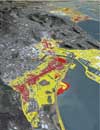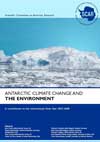[youtube]DLViKhITbrA[/youtube]
If you want to know what’s happening on a stockmarket, the first place to look is at the relevant index — the Footsie (FTSE) for the London Stock Exchange, or the Dow Jones for Wall Street. Those indices aggregate all the price movements over a day into one handy number, to give a quick overview of how the market’s behaving. Now a group of scientists working for the International Geosphere-Biosphere Programme (IGBP) have compiled a Climate Change Index (CCI) to provide the same service for the evidence of climate change. The CCI was launched in Copenhagen yesterday. The video above describes the approach they’ve used, and the “ladder” graphic below shows how the CCI has moved over the last 30 years:

The CCI tracks changes in global temperature, atmospheric CO2, Arctic sea ice, and sea level. An increase in the CCI shows a move away from a stable climate. Over the last 30 years the cumulative shift has been 574 points — in the wrong direction. The IGBP team point out that the CCI responds to global cooling events such as the Pinatubo and El Chichon eruptions, but they are also looking at adding other indicators to the index including land-use, fisheries exploitation, population, fire and extreme events. They are planning to update the index every year, and to backdate it to periods before 1980.
[The Drifters]
Like this:
Like Loading...
 Plan for two metres sea level rise this century. That’s the message from Rob Young and Orrin Pilkey in a Yale Environment article published today.
Plan for two metres sea level rise this century. That’s the message from Rob Young and Orrin Pilkey in a Yale Environment article published today.



 “The
“The